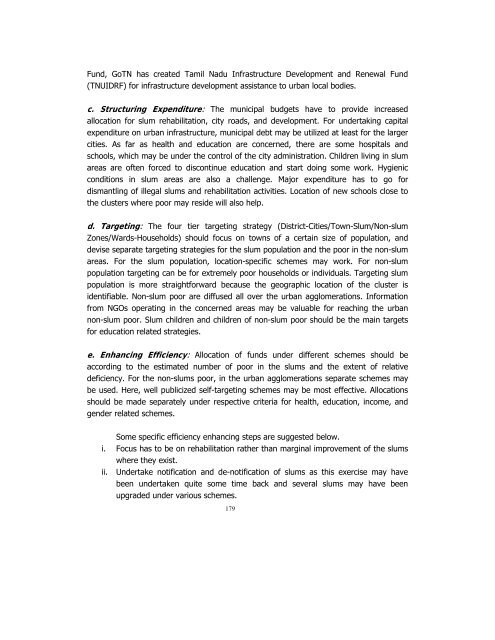POVERTY REDUCTION STRATEGY TN
You also want an ePaper? Increase the reach of your titles
YUMPU automatically turns print PDFs into web optimized ePapers that Google loves.
Fund, Go<strong>TN</strong> has created Tamil Nadu Infrastructure Development and Renewal Fund<br />
(<strong>TN</strong>UIDRF) for infrastructure development assistance to urban local bodies.<br />
c. Structuring Expenditure: The municipal budgets have to provide increased<br />
allocation for slum rehabilitation, city roads, and development. For undertaking capital<br />
expenditure on urban infrastructure, municipal debt may be utilized at least for the larger<br />
cities. As far as health and education are concerned, there are some hospitals and<br />
schools, which may be under the control of the city administration. Children living in slum<br />
areas are often forced to discontinue education and start doing some work. Hygienic<br />
conditions in slum areas are also a challenge. Major expenditure has to go for<br />
dismantling of illegal slums and rehabilitation activities. Location of new schools close to<br />
the clusters where poor may reside will also help.<br />
d. Targeting: The four tier targeting strategy (District-Cities/Town-Slum/Non-slum<br />
Zones/Wards-Households) should focus on towns of a certain size of population, and<br />
devise separate targeting strategies for the slum population and the poor in the non-slum<br />
areas. For the slum population, location-specific schemes may work. For non-slum<br />
population targeting can be for extremely poor households or individuals. Targeting slum<br />
population is more straightforward because the geographic location of the cluster is<br />
identifiable. Non-slum poor are diffused all over the urban agglomerations. Information<br />
from NGOs operating in the concerned areas may be valuable for reaching the urban<br />
non-slum poor. Slum children and children of non-slum poor should be the main targets<br />
for education related strategies.<br />
e. Enhancing Efficiency: Allocation of funds under different schemes should be<br />
according to the estimated number of poor in the slums and the extent of relative<br />
deficiency. For the non-slums poor, in the urban agglomerations separate schemes may<br />
be used. Here, well publicized self-targeting schemes may be most effective. Allocations<br />
should be made separately under respective criteria for health, education, income, and<br />
gender related schemes.<br />
Some specific efficiency enhancing steps are suggested below.<br />
i. Focus has to be on rehabilitation rather than marginal improvement of the slums<br />
where they exist.<br />
ii. Undertake notification and de-notification of slums as this exercise may have<br />
been undertaken quite some time back and several slums may have been<br />
upgraded under various schemes.<br />
179

















